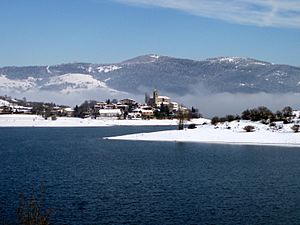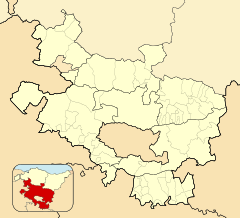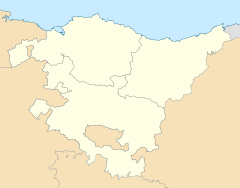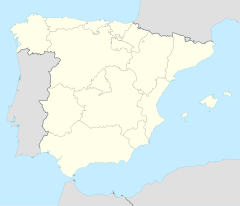Ullíbarri-Gamboa facts for kids
Quick facts for kids
Ullíbarri-Gamboa
|
|
|---|---|

Ullíbarri-Gamboa in the winter, view from the dam
|
|
| Country | Spain |
| Autonomous community | Basque Country |
| Province | Álava |
| Comarca | Gorbeialdea |
| Municipality | Arratzua-Ubarrundia |
| Area | |
| • Total | 7.23 km2 (2.79 sq mi) |
| Elevation | 559 m (1,834 ft) |
| Population | |
| • Total | 81 |
| • Density | 11.20/km2 (29.02/sq mi) |
| Postal code |
01520
|
Ullíbarri-Gamboa is a small village, also called a concejo, located in the area of Arratzua-Ubarrundia. It is part of the Álava province in the Basque Country, Spain.
This village is famous because it gives its name to the Ullíbarri-Gamboa Reservoir. This reservoir is the biggest one in the entire Basque Country. When the dam was built between 1947 and 1956, some parts of the village and most of its farming land were covered by water. Because of this, many people who lived there had to move to the nearby city of Vitoria-Gasteiz.
Contents
What Does the Name Ullíbarri-Gamboa Mean?
The name Ullíbarri comes from the Basque words uri (an old word for "city") and barri (a way of saying "new"). So, Ullíbarri literally means "new town."
Gamboa is the name of the valley that was flooded when the reservoir was built. It was also the name of a former area nearby. Interestingly, Ullíbarri-Gamboa itself was not originally part of that Gamboa area.
Famous People from Ullíbarri-Gamboa
Some important people have come from Ullíbarri-Gamboa. They achieved great things in different parts of the world.
Bartolomé de Letona: A Friar and Writer
Bartolomé de Letona lived in the 1600s. He was a Franciscan friar, which is a type of religious brother. He held important jobs in places like Mexico and the Philippines. Bartolomé de Letona also wrote several books about religion and about the Philippine Islands.
Tomás Ruiz de Azúa: A Military Leader
Tomás Ruiz de Azúa was born in 1659 and lived until 1731. He was a military officer who worked in Chile. He became a mayor in the city of Santiago de Chile and later served as the governor of Valparaíso.
Francisco Ruiz de Azúa: A Missionary Bishop
Francisco Ruiz de Azúa lived from 1868 to 1929. He was a Benedictine monk and a missionary. A missionary is someone who travels to spread their religious beliefs. In 1919, he became the Bishop of Eastern Tonkin.
See also
 In Spanish: Ullívarri-Gamboa para niños
In Spanish: Ullívarri-Gamboa para niños




